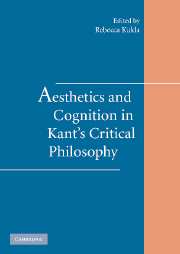Book contents
- Frontmatter
- Contents
- Notes on Contributors
- Acknowledgments
- 1 Introduction: Placing the Aesthetic in Kant's Critical Epistemology
- PART I SENSIBLE PARTICULARS AND DISCURSIVE JUDGMENT
- PART II THE COGNITIVE STRUCTURE OF AESTHETIC JUDGMENT
- 5 Dialogue: Paul Guyer and Henry Allison on Allison's Kant's Theory of Taste
- 6 Intensive Magnitudes and the Normativity of Taste
- 7 The Harmony of the Faculties Revisited
- 8 Kant's Leading Thread in the Analytic of the Beautiful
- PART III CREATIVITY, COMMUNITY, AND REFLECTIVE JUDGMENT
- Bibliography
- Index
8 - Kant's Leading Thread in the Analytic of the Beautiful
Published online by Cambridge University Press: 24 July 2009
- Frontmatter
- Contents
- Notes on Contributors
- Acknowledgments
- 1 Introduction: Placing the Aesthetic in Kant's Critical Epistemology
- PART I SENSIBLE PARTICULARS AND DISCURSIVE JUDGMENT
- PART II THE COGNITIVE STRUCTURE OF AESTHETIC JUDGMENT
- 5 Dialogue: Paul Guyer and Henry Allison on Allison's Kant's Theory of Taste
- 6 Intensive Magnitudes and the Normativity of Taste
- 7 The Harmony of the Faculties Revisited
- 8 Kant's Leading Thread in the Analytic of the Beautiful
- PART III CREATIVITY, COMMUNITY, AND REFLECTIVE JUDGMENT
- Bibliography
- Index
Summary
Kant conducts his Analytic of the Beautiful, in the Critique of the Power of Judgment, according to the “leading thread” that also guided the table of the categories in the first Critique: the four titles of the logical functions of judgement. This leading thread, which has not met with much favor on the part of Kant's readers where the first Critique is concerned, is even less popular in the case of the third Critique. In this essay, I will argue that this ill repute is unmerited. In fact, Kant's use of the leading thread of the logical functions of judgment to analyze judgments of taste merits close attention. In particular, it brings to light a striking feature of judgments of taste as analyzed by Kant. We would expect the main headings in the table of logical functions (quantity, quality, relation, modality) to guide the analysis of aesthetic judgments as judgments about an object (“this rose is beautiful,” “this painting is beautiful”). Now they certainly do serve this purpose. But in addition, it turns out that they also serve to analyze another judgment, one that remains implicitly contained within the predicate (‘beautiful’) of the judgments of taste. This second judgment, embedded, as it were, in the first (or in the predicate of the first), and that only the critique of taste brings to discursive clarity, is a judgment no longer about the object, but about the judging subjects, namely, the subjects that pass the judgment: “this rose is beautiful,” “this painting is beautiful,” and so on.
- Type
- Chapter
- Information
- Aesthetics and Cognition in Kant's Critical Philosophy , pp. 194 - 220Publisher: Cambridge University PressPrint publication year: 2006
- 8
- Cited by



